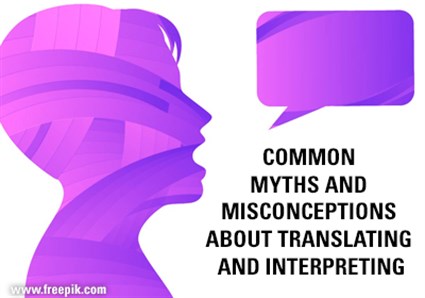Common Myths and Misconceptions of Translation and Interpretation
In a previous blog, Translation vs. Interpretation, we discussed how the words “translation” and “interpretation” are commonly used interchangeably. However, they are two different professions, which share characteristics. These professions are also surrounded by a number of myths and misconceptions and, in fact, their interchangeability is their first misconception.
In this blog, I will highlight five common myths and misconceptions regarding translation and interpretation.
5 Common Myths and Misconceptions
1. Any bilingual or multilingual person can be a translator or an interpreter.

A professional translator or interpreter is needed to convey the appropriate meaning of a message into a target language. Therefore, they must have excellent communication skills and fluency in a number of languages. But simply being fluent in more than one language isn’t enough to be a successful translator or interpreter.
Understanding and analyzing the source language content and message and rendering it into the target language is essential. For the best results, training based on language structures, terminology and research, as well as effective communication skills such as drafting for translators and oratory for interpreters make a large difference among the professionals.
2. Any good translator or interpreter works in any subject matter or area of expertise.
To complete a high quality translation or interpretation, the professional needs the set of skills in his or her language combinations, as well as deep knowledge of the field or industry he or she is working in. The subject matter should be approached with as much severity as possible.
For example, a translator working with pharmaceutical documents, likely doesn’t also translate hotel websites or restaurant menus, even if the language pairs are the same. A deep understanding of the language, culture and locale are important but an understanding of the subject matter is just as important. This specialized knowledge can be developed by studying, researching or having a relevant degree.

3 . Any translator or interpreter works in any direction.
Although there are exceptions, in general, professional translators and interpreters only translate or interpret into their native language. An extensive knowledge of the culture, political climate, current events and common expressions are needed to convey the most accurate meaning.
Interpreters more often work in both directions on the spot and, for that reason, they must rely on excellent public speaking skills and cultural background. They will have to interpret culturally-specific references not only at the linguistic level, but also at the paralinguistic level, in such a way the audience can understand.
4. Technology is reducing the need for translators and interpreters.
It is widely accepted that technological developments help improve an industry. However, in the translation and interpretation industry humans are necessary to ensure the technology is accurately and appropriately used. Machine translation is making great strides in becoming more accurate, but still has a long way to go before it can correctly translate meaning. Without humans, cultural terms, colloquialisms and dialectical differences can easily get lost in literal machine translation.
Due to high demand, professional translators and interpreters are facing increased pressure. Shorter delivery times, lower rates, and machine translation first and post editing afterwards are some of the factors affecting their work. Human translators and machine translation technologies are still trying to coexist in a balanced way.
5 . Translators do literary translation and interpreters work at the United Nations.
Although they seem to be the most visible fields for each of the professions, the truth is that the market is considerably wider. Apart from literary translation and conference interpreting, there are industries that require greater work, such us software, healthcare, finance, manufacturing and hospitality, among others, both for translation as well as interpreting services.
Summary
Translating and interpreting have been part of history from the very beginning, acting as bridges among communities and societies. It is helpful to see how these two professionals are similar and how they differ. This industry continues to grow so it’s necessary to debunk the myths associated with the professions so people can better understand how these professionals work.
